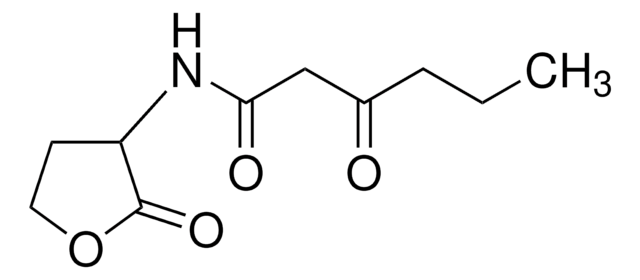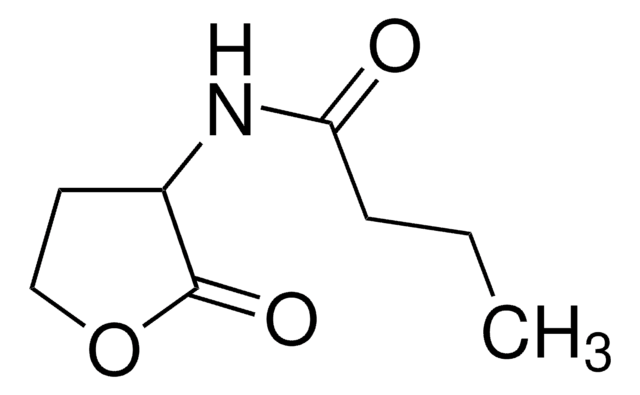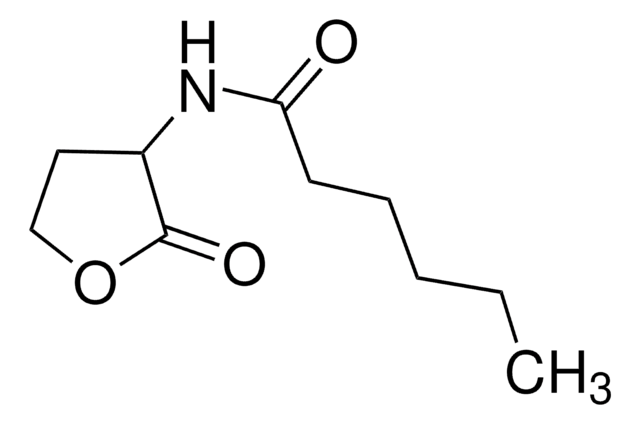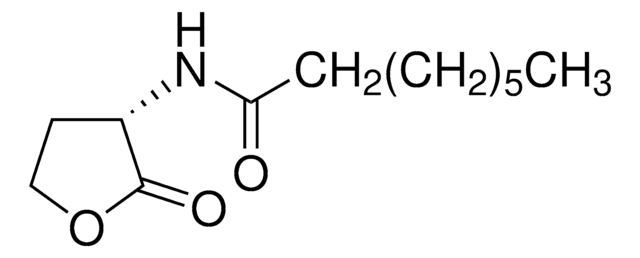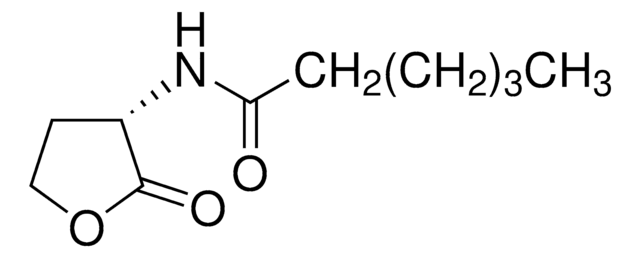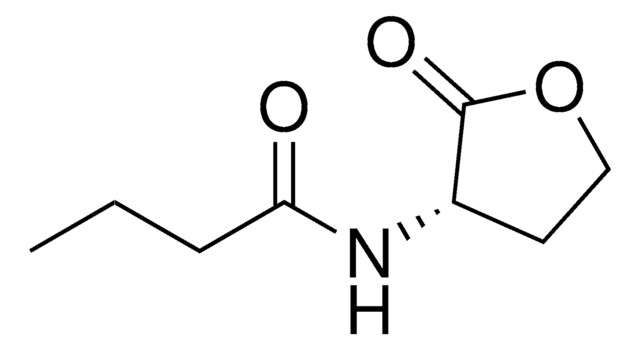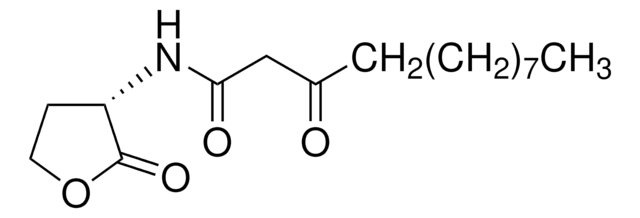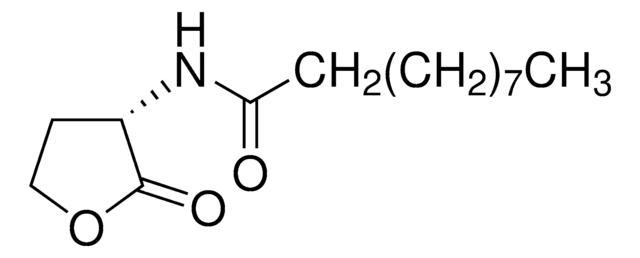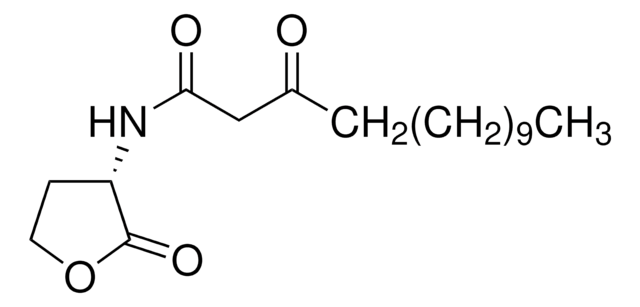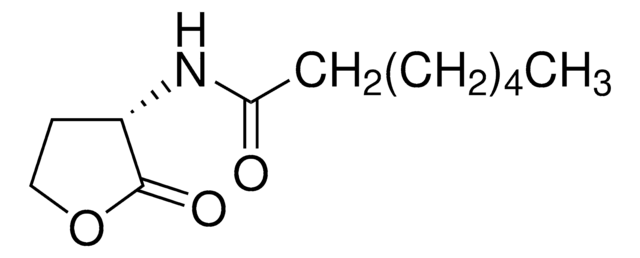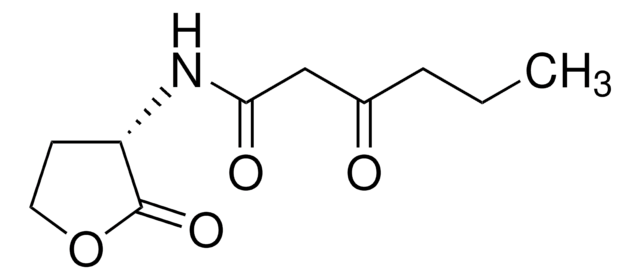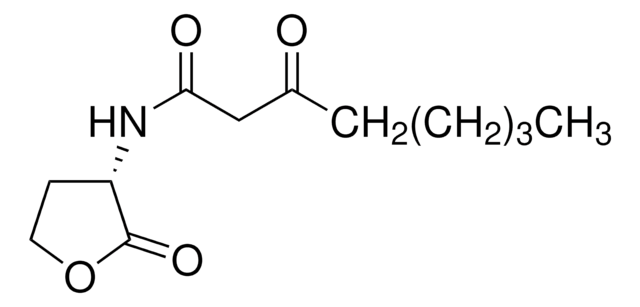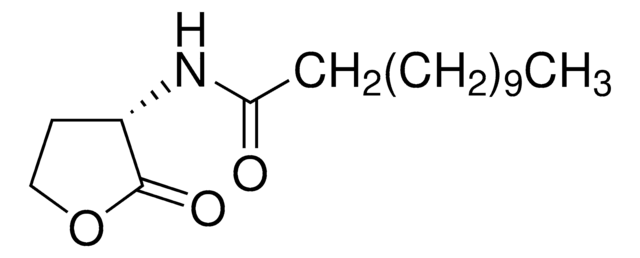10940
N-Octanoyl-DL-homoserine lactone
≥97.0% (HPLC)
Synonym(s):
N-Capryloyl-DL-homoserine lactone
Sign Into View Organizational & Contract Pricing
All Photos(1)
About This Item
Empirical Formula (Hill Notation):
C12H21NO3
CAS Number:
Molecular Weight:
227.30
Beilstein/REAXYS Number:
1642628
MDL number:
UNSPSC Code:
12352209
eCl@ss:
32160406
PubChem Substance ID:
NACRES:
NA.26
Recommended Products
Product Name
N-Octanoyl-DL-homoserine lactone, ≥97.0% (HPLC)
Quality Level
assay
≥97.0% (HPLC)
form
powder with small lumps
color
white to faintly beige
application(s)
detection
storage temp.
2-8°C
SMILES string
CCCCCCCC(=O)NC1CCOC1=O
InChI
1S/C12H21NO3/c1-2-3-4-5-6-7-11(14)13-10-8-9-16-12(10)15/h10H,2-9H2,1H3,(H,13,14)
InChI key
JKEJEOJPJVRHMQ-UHFFFAOYSA-N
Application
Application test: Induces violacein expression in a Chromobacterium violaceum mutant usually not able to produce homoserine lactones.
Biochem/physiol Actions
N-Octanoyl-DL-homoserine lactone is a member of N-acyl-homoserine lactone family. N-acylhomoserine lactones (AHL) regulate gene expression in gram-negative bacteria, such as Echerichia and Salmonella are involved in quorum sensing, cell to cell communication among bacteria. Some AHLs are potent chemoattractants for human immune cells such as neutrophils.
N-octanoyl-homoserine lactone (N-C8-HSL) is among a group of homoserine lactones that includes; N-Heptanoyl-DL-homoserine lactone (C7HSL), N-Decanoyl-DL-homoserine lactone (N-C10-HSL), N-(3-oxodecanoyl) homoserine-L-lactone (3-oxo-C10 HSL), N-(3-oxododecanoyl)homoserine-L-lactone (3-oxo-C12-HSL), N-(3-Oxotetradecanoyl)-L-homoserine lactone (3-oxo-C14-HSL, N-(3-hydroxydecanoyl)-L-homoserine lactone, and N-(3-hydroxyoctanoyl)-L-homoserine lactone involved in the processes of bacterial quorum sensing. These N-acyl-homoserine lactones are used to study the processes and mechanisms of bacterial quorum sensing.
Storage Class
11 - Combustible Solids
wgk_germany
WGK 3
flash_point_f
Not applicable
flash_point_c
Not applicable
ppe
Eyeshields, Gloves, type N95 (US)
Choose from one of the most recent versions:
Already Own This Product?
Find documentation for the products that you have recently purchased in the Document Library.
Customers Also Viewed
Hebert F Culler et al.
Genes, 9(5) (2018-05-16)
Atypical enteropathogenic Escherichia coli are capable to form biofilm on biotic and abiotic surfaces, regardless of the adherence pattern displayed. Several E. coli mechanisms are regulated by Quorum sensing (QS), including virulence factors and biofilm formation. Quorum sensing is a
Hongsup Kim et al.
Journal of bacteriology, 194(5), 982-992 (2011-12-20)
Burkholderia glumae possesses a quorum-sensing (QS) system mediated by N-octanoyl-homoserine lactone (C(8)-HSL) and its cognate receptor TofR. TofR/C(8)-HSL regulates the expression of a transcriptional regulator, qsmR. We identified one of the universal stress proteins (Usps), Usp2, from a genome-wide analysis
Francisco Pérez-Montaño et al.
Research in microbiology, 162(7), 715-723 (2011-05-24)
Legume-nodulating rhizobia use N-acyl homoserine lactones (AHLs) to regulate several physiological traits related to the symbiotic plant-microbe interaction. In this work, we show that Sinorhizobium fredii SMH12, Rhizobium etli ISP42 and Rhizobium sullae IS123, three rhizobial strains with different nodulation
Xinqi Huang et al.
Current microbiology, 74(1), 68-76 (2016-11-04)
Marine algae provide a unique niche termed the phycosphere for microorganism inhabitation. The phycosphere environment is an important niche for mutualistic and competitive interactions between algae and bacteria. Quorum sensing (QS) serves as a gene regulatory system in the microbial
Ali E McClean et al.
Phytopathology, 102(2), 195-203 (2012-01-13)
Several members of the bacterial genus Brenneria are pathogenic on different tree species. Cell-free extracts from the bacterial phytopathogens Brenneria rubrifaciens, B. salicis, and B. nigrifluens induced production of the red pigment rubrifacine in the B. rubrifaciens bruI insertional mutant
Our team of scientists has experience in all areas of research including Life Science, Material Science, Chemical Synthesis, Chromatography, Analytical and many others.
Contact Technical Service